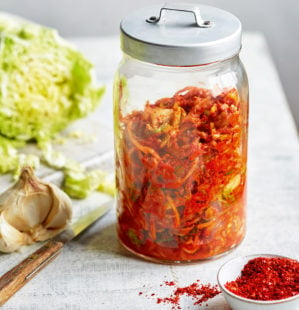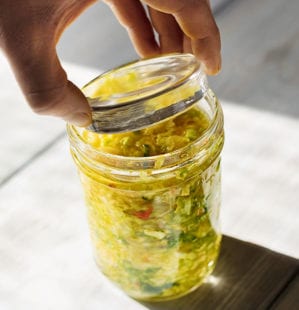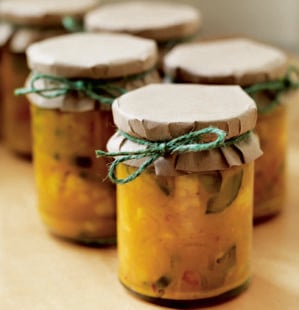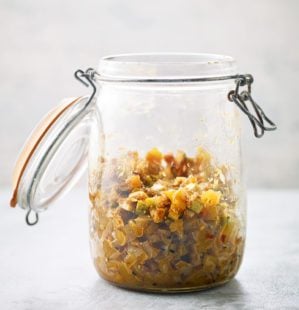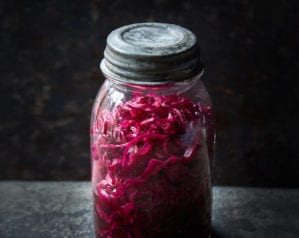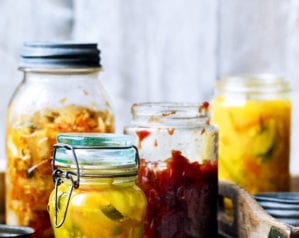
Smoky kale and carrot sauerkraut
- Published: 2 Oct 23
- Updated: 18 Mar 24
Kale and carrots give cabbage sauerkraut extra vibrancy and flavour. ’Kraut’s tangy taste comes from lacto-fermentation – a simple process that uses nothing more than salt and oxygen. The salt kills the ‘bad’ bacteria and helps the salt-tolerant lacto-bacteria thrive. If you’re new to fermenting, this is a great place to start.
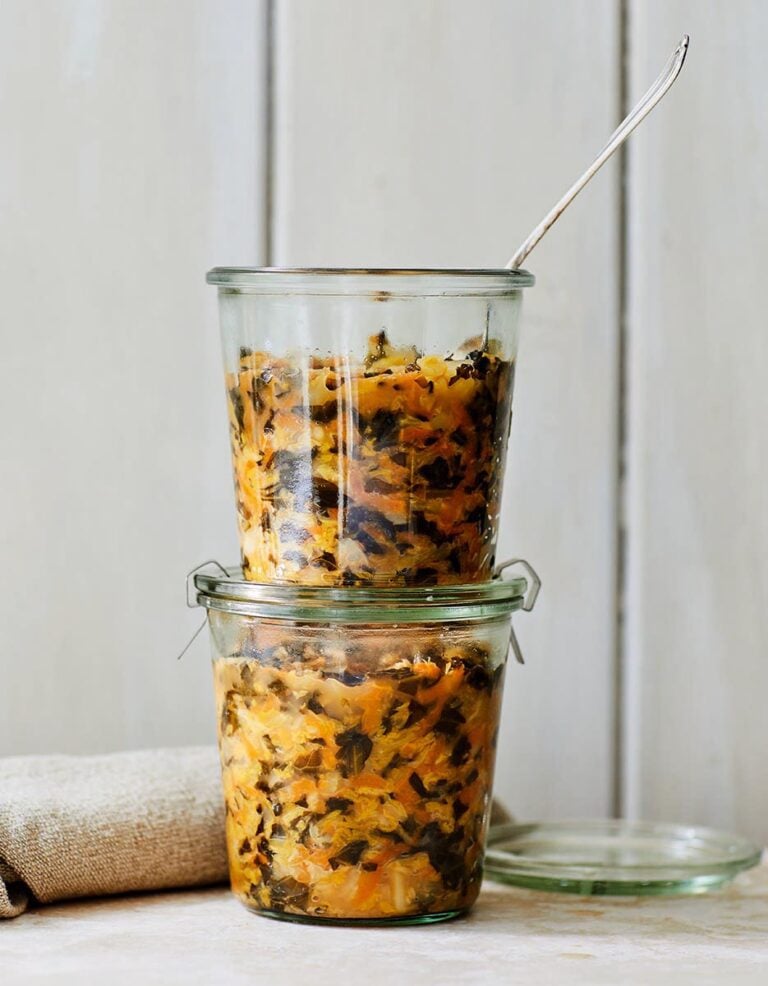
Got a taste for ferments? Try our kimchi recipe next.
-
Makes about 1kg
-
Hands-on time 40 min, plus 10-14 days fermenting
Ingredients
- 1 white cabbage (700-800g)
- 250g kale
- 2 carrots (about 250g)
- About 25g smoked salt (or less/more as needed)
- 1 tbsp black peppercorns
- 1 tsp fennel seeds
You’ll also need
- 2 x 500g sterilised preserving jars (see Know-how)
Method
- Remove two of the outer leaves of the cabbage and set aside. Finely slice the cabbage, removing (but reserving) the core. Finely slice the kale, stripping out the stalks as you go (reserve a few of these too) and coarsely grate the carrots. Weigh the veg in a large and spotlessly clean bowl, then work out 2.2% of the total weight to calculate how much salt you need (see Know-how). Crush the salt you need in a pestle and mortar until fine, then sprinkle over the veg. Massage the salt into the vegetables using your fingertips for 5-10 minutes until watery and limp. Set the veg aside for 45 minutes.
- Lightly crush the peppercorns and fennel seeds in a pestle and mortar, then stir into the sauerkraut mixture. Transfer to the jars, making sure you pack them down well, using your (clean) fist or the pestle as you go – the kraut should be a tight fit without any air pockets. Pour in any juice from the bowl; the veg should be fully submerged in the liquid. Sit a reserved cabbage leaf on top to cover, then use the core and/or kale stalks to wedge it all in place below the surface of the liquid. (You could also use a fermenting weight.) Cover with a clean, heavy cloth, keeping it in place with an elastic band. Alternatively, use a fermentation jar with the valve open – the gasses that build up while the sauerkraut ferments need to be able to escape.
- Leave the sauerkraut to ferment at room temperature for 10-14 days. Check it every now and then – you may need to remove a little liquid from the jar if it gets near the top. Just make sure the veg stays submerged. After 10 days, taste the kraut and decide if you’d prefer it to be stronger or if it’s ready. Once you like the taste, seal the jar and transfer to the fridge. It will keep chilled for 3 months. Once opened, eat within 1 month.
- Recipe from October 2023 Issue
Nutrition
- Calories
- 5kcals
- Fat
- 0g
- Protein
- 0.5g
- Carbohydrates
- 0.7g (0.6g sugars)
- Fibre
- 0.5g
- Salt
- 0.3g
delicious. tips
To make a cabbage sauerkraut you’d usually use 2% salt, but we’ve added a little more here as kale is tougher than cabbage and the extra salt helps tenderise it. To calculate 2.2% salt: total veg weight in grams ÷ 100 x 2.2 = amount of salt required in grams.
Find out how to sterilise jars.
Buy ingredients online
Rate & review
Rate
Reviews
Subscribe to our magazine
Food stories, skills and tested recipes, straight to your door... Enjoy 5 issues for just £5 with our special introductory offer.
Subscribe
Unleash your inner chef
Looking for inspiration? Receive the latest recipes with our newsletter



